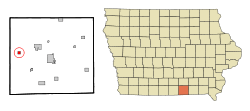Plano, Iowa
Plano is a city in Appanoose County, Iowa, United States. The population was 70 at the 2010 census.
Plano, Iowa | |
|---|---|
 Location of Plano, Iowa | |
| Coordinates: 40°45′22″N 93°2′47″W | |
| Country | |
| State | |
| County | Appanoose |
| Area | |
| • Total | 0.56 sq mi (1.46 km2) |
| • Land | 0.56 sq mi (1.46 km2) |
| • Water | 0.00 sq mi (0.00 km2) |
| Elevation | 1,033 ft (315 m) |
| Population | |
| • Total | 70 |
| • Estimate (2019)[3] | 67 |
| • Density | 118.79/sq mi (45.84/km2) |
| Time zone | UTC-6 (Central (CST)) |
| • Summer (DST) | UTC-5 (CDT) |
| ZIP code | 52581 |
| Area code(s) | 641 |
| FIPS code | 19-63345 |
| GNIS feature ID | 0460204 |
History
Plano was incorporated in 1916.[4] A large portion of the early settlers being natives of Plano, Illinois, caused the name to be selected.[5]
Geography
Plano is located at 40°45′22″N 93°2′47″W (40.756189, -93.046327).[6]
According to the United States Census Bureau, the city has a total area of 0.56 square miles (1.45 km2), all land.[7]
Demographics
| Year | Pop. | ±% |
|---|---|---|
| 1920 | 272 | — |
| 1930 | 153 | −43.8% |
| 1940 | 209 | +36.6% |
| 1950 | 106 | −49.3% |
| 1960 | 87 | −17.9% |
| 1970 | 109 | +25.3% |
| 1980 | 111 | +1.8% |
| 1990 | 75 | −32.4% |
| 2000 | 58 | −22.7% |
| 2010 | 70 | +20.7% |
| 2019 | 67 | −4.3% |
| Source:"U.S. Census website". United States Census Bureau. Retrieved 2020-03-29. and Iowa Data Center Source: | ||
2010 census
As of the census[2] of 2010, there were 70 people, 30 households, and 18 families living in the city. The population density was 125.0 inhabitants per square mile (48.3/km2). There were 37 housing units at an average density of 66.1 per square mile (25.5/km2). The racial makeup of the city was 90.0% White, 8.6% African American, and 1.4% from two or more races. Hispanic or Latino of any race were 8.6% of the population.
There were 30 households, of which 23.3% had children under the age of 18 living with them, 46.7% were married couples living together, 6.7% had a female householder with no husband present, 6.7% had a male householder with no wife present, and 40.0% were non-families. 36.7% of all households were made up of individuals, and 26.7% had someone living alone who was 65 years of age or older. The average household size was 2.33 and the average family size was 2.89.
The median age in the city was 39.5 years. 27.1% of residents were under the age of 18; 3% were between the ages of 18 and 24; 21.4% were from 25 to 44; 20% were from 45 to 64; and 28.6% were 65 years of age or older. The gender makeup of the city was 52.9% male and 47.1% female.
2000 census
As of the census[9] of 2000, there were 58 people, 29 households, and 20 families living in the city. The population density was 102.7 people per square mile (40.0/km2). There were 40 housing units at an average density of 70.8 per square mile (27.6/km2). The racial makeup of the city was 94.83% White, and 5.17% from two or more races. Hispanic or Latino of any race were 1.72% of the population.
There were 29 households, out of which 17.2% had children under the age of 18 living with them, 51.7% were married couples living together, 6.9% had a female householder with no husband present, and 31.0% were non-families. 31.0% of all households were made up of individuals, and 10.3% had someone living alone who was 65 years of age or older. The average household size was 2.00 and the average family size was 2.40.
In the city, the population was spread out, with 12.1% under the age of 18, 5.2% from 18 to 24, 15.5% from 25 to 44, 48.3% from 45 to 64, and 19.0% who were 65 years of age or older. The median age was 54 years. For every 100 females, there were 100.0 males. For every 100 females age 18 and over, there were 112.5 males.
The median income for a household in the city was $30,625, and the median income for a family was $33,125. Males had a median income of $28,750 versus $27,000 for females. The per capita income for the city was $22,474. There were 20.0% of families and 23.1% of the population living below the poverty line, including no under eighteens and 13.3% of those over 64.
References
- "2019 U.S. Gazetteer Files". United States Census Bureau. Retrieved July 17, 2020.
- "U.S. Census website". United States Census Bureau. Retrieved 2012-05-11.
- "Population and Housing Unit Estimates". United States Census Bureau. May 24, 2020. Retrieved May 27, 2020.
- "Plano, Iowa". City-Data.com. Retrieved 13 February 2014.
- Encyclopedia of Iowa. North American Book Dist LLC. 1 January 1995. p. 254. ISBN 978-0-403-09918-4.
- "US Gazetteer files: 2010, 2000, and 1990". United States Census Bureau. 2011-02-12. Retrieved 2011-04-23.
- "US Gazetteer files 2010". United States Census Bureau. Archived from the original on 2012-07-02. Retrieved 2012-05-11.
- "Census of Population and Housing". Census.gov. Retrieved June 4, 2015.
- "U.S. Census website". United States Census Bureau. Retrieved 2008-01-31.